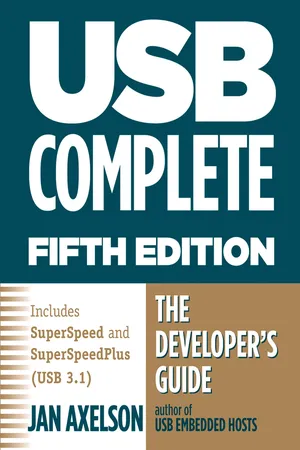
- English
- ePUB (mobile friendly)
- Available on iOS & Android
About this book
Now in its fifth edition, bridges the gap between the technical specifications and the real world of designing and programming devices that connect over the Universal Serial Bus (USB). Readers will learn how to select the appropriate USB speed, device class, and hardware for a device; communicate with devices using Visual C# and Visual Basic; use standard host drivers to access devices, including devices that perform vendor-defined tasks; save power with USB's built-in power-conserving protocols; and create robust designs using testing and debugging tools. This fully revised edition also includes instruction on how to increase bus speed with SuperSpeed and SuperSpeedPlus, implement wireless communications, and develop for USB On-The-Go and embedded hosts.
Frequently asked questions
- Essential is ideal for learners and professionals who enjoy exploring a wide range of subjects. Access the Essential Library with 800,000+ trusted titles and best-sellers across business, personal growth, and the humanities. Includes unlimited reading time and Standard Read Aloud voice.
- Complete: Perfect for advanced learners and researchers needing full, unrestricted access. Unlock 1.4M+ books across hundreds of subjects, including academic and specialized titles. The Complete Plan also includes advanced features like Premium Read Aloud and Research Assistant.
Please note we cannot support devices running on iOS 13 and Android 7 or earlier. Learn more about using the app.
Information
Table of contents
- Cover
- Title Page
- Copyright
- Contents
- Introduction
- 1 USB Basics
- 2 Inside USB Transfers
- 3 A Transfer Type for Every Purpose
- 4 Enumeration: How the Host Learns about Devices
- 5 Control Transfers: Structured Requests for Critical Data
- 6 Chip Choices
- 7 Device Classes
- 8 How the Host Communicates
- 9 Matching a Driver to a Device
- 10 Detecting Devices
- 11 Human Interface Devices: Capabilities
- 12 Human Interface Devices: Reports
- 13 Human Interface Devices: Host Application
- 14 Using WinUSB for Vendor-defined Functions
- 15 Using WinUSB’s System INF File
- 16 Using Hubs to Extend and Expand the Bus
- 17 Managing Power
- 18 Testing and Debugging
- 19 Packets on the Bus
- 20 Electrical and Mechanical Interface
- 21 Hosts for Embedded Systems